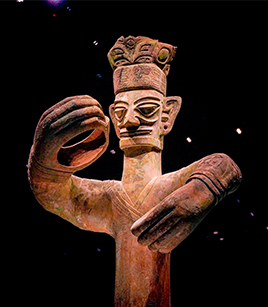
A sculpture unearthed from the Sanxingdui site in 1986 Photo: CFP
The history of Sanxingdui is completely absent from any archives, and archaeological discoveries have revealed a previously unknown regional culture. However, Shi Jinsong, a research fellow from the Institute of Archaeology at CASS, believed that the Sanxingdui culture neither appeared suddenly nor disappeared mysteriously, and it had connections and exchanges with other cultures at that time. In the Chengdu Plain where the Sanxingdui site is located, archaeologists discovered eight Neolithic sites. The development of local Neolithic culture laid the foundation for the birth of the Sanxingdui culture. The concept of using a gold scepter and other gold artifacts as symbols of power at Sanxingdui might have come from northwest China. Studies show that most ancient scepters were unearthed in northwest China, which date back to 5,000 to 3,000 years ago.
Shi Jinsong believes that the Sanxingdui culture didn’t mysteriously disappear. After the political, cultural, and religious center of the Chengdu Plain shifted from Sanxingdui to Jinsha [an archaeological site located in Chengdu], this culture continued in Jinsha. The unearthed items from Sanxingdui and Jinsha are basically the same in type, shape, and design, indicating that they were made almost in the same way. There are no large tombs at Sanxingdui or Jinsha, and most of the valuables were used for sacrificial rituals rather than funerary goods. This indicates that Sanxingdui and Jinsha were dominated by a theocracy at the time, and the ruling class applied social wealth in religious activities rather than personal funerals, which was completely different from the Shang and Zhou cultures of the same period.
Between the end of the Western Zhou Dynasty (1046–771 BCE) and the early Spring and Autumn Period (770–476 BCE), the Sanxingdui-Jinsha culture began to be replaced by a new culture, the Ba culture, which was represented by the disappearance of the sacrificial remains of the Sanxingdui-Jinsha culture and the extinction of beliefs such as sun worship, while the function of bronzeware was changed from sacrificial utensils to daily utensils and funerary utensils. These changes were related to the decline of the Sanxingdui-Jinsha culture and the westward expansion of the Central Plain culture.
Edited by Ren Guanhong


 PRINT
PRINT CLOSE
CLOSE